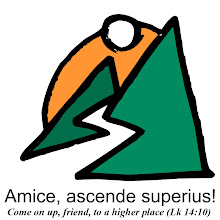GROWING STRONG AT BROKEN PLACES:[1]
Wholeness, some authors rightly say, has to do partly with the ability to be at home with paradox. Paradox refers to any reality that cannot be reduced to either black or white, black and white, or just nondescript shades of grey. Paradox refers to a reality that is both black and white, at one and the same time. Sometimes it is more like the former; sometimes it is more like the latter.
Cognitive-behavioral therapists are all too familiar with that dysfunctional mental schema called “black or white thinking.” It is that “either/or” rigid attitude that gets lost when what one talks about cannot be rigidly defined in terms of two conflicting, and irreconcilable extremes. Mental health, the same therapists say, and I agree, has to do with the ability to navigate between the Scylla and Charybdis[2] shoals of either/or, and black or white thinking. Veer too much on the left and the boat founders. Steer too much on the right and the boat shudders to a splashing halt. The siren songs of rigid, compartmentalized thinking have caused many a ship of otherwise capable personalities flounder on the shoals of paralysis and dysfunctionality.
In my experience as a counselor, I have increasingly grown convinced of – at least for me – an emerging paradox. Sometimes, in order for one to get a breakthrough, ironically all he needs is a breakdown. A breakthrough happens when one’s defenses collapse and one hits rock bottom. But before it can happen, one literally needs to allow that breakdown and collapse to happen. One allows oneself to be wounded all over again, at least temporarily, to revisit a past event, relive it with all its concomitant pain and misery, in order to rewrite that same painful memory and set out on the difficult path of writing new life scripts.[3]
The paradox increases in scope. One realizes in time that what one is afraid of, what one is trying so hard to push away and deny, is what precisely keeps us paralyzed, dysfunctional persons to ourselves and others, and what perpetuates our misery in the long run. More than just this, what we blame others for, is the very thing that we cannot even name and claim – let alone – tame in ourselves. What we deny is what we project. What we deny somehow attains a life of its own, and holds us in its powerful grip, thereby rendering us no more than just slaves of our own dysfunctionalities and hopelessly attached even to the very pain we hate and which we would like to go away.
Scriptures are never wanting for models and examples that illustrate the many problems we encounter – along with the redemption that ensued when said individuals literally and figuratively bit the dust and embraced their brokenness. The one that immediately comes to mind is
Interestingly, Paul embraced his brokenness. He went down to the depths of admission even of guilt and sin, and that paved the way to forgiveness and salvation.
As a young professed religious, I had a particularly unforgettable experience in boonies of Calamba in the late 70s. I was teaching catechism in Barrio Barandal. One afternoon, during a brief lull from class, I went out to take a breather. By the side of the road was mango sapling about a meter tall. Not having anything better to do, I decided right then and there to tie a knot using the mango sapling as rope. The knot was tied right in the middle of the growing sapling’s main stem. More than a decade later, I went back there as a young priest. The first thing I looked for was that mango tree. I felt for the knot. I found it and touched it. It had grown strong at its broken place.
One thing about us religious men is that we know a whole lot about one another in our communities, but at the same time, we don’t know a whole lot about one another. Growing up together in formation houses lent us the rare opportunity of getting a front seat view to all our quirks of personalities, our tastes, our pet peeves, our dreams, and even at times, our ulterior motives. The rare psychological intuitives in our midst would perhaps essay a guess as to what our real motives are in any given situation, but by far, the great majority would only go by the rule popularized by GUI of Macintosh: “What you see is what you get (WYSIWYG). But as we grew up into becoming young adults, as we began to navigate the troubled seas of midlife transition, as we tasted a little power and prestige, as we got to know the hidden powers waiting in the wings to be tapped to full capacity, perhaps talents we never knew we had, we suddenly saw our potentials, our power, our capacities. And some of us didn’t know how to handle success. Some of us may have been caught off balance by the newfound freedom, and the possibility to catch up with the individuation needs we never got around to doing, growing up as we did in the context of rigid formation in the seminary.
Soon it was either one or the other. Either we were getting broken, or we were breaking the backs of other people. Our personal paralysis somehow finds a ready and willing receptacle. Misery loves company. And a dumping ground of all our negativities is what we are looking for all the time. Soon we find ourselves reacting disproportionately negative to what objectively are really innocent – if, at the most, thoughtless – behavior of others, especially if those others were superiors or at least were perceived to be powerful. Soon, we were out on a witch hunt, searching for faults in other people, including conjectures, rash judgments, imaginary hurts and insults. We were hurting and people who are hurting end up hurting others. That is, if one is unable even to accept he is hurting deep inside.
I got bad news for superiors. If you have accepted to be one, then you must have very broad shoulders. For one, it just is your unfortunate lot to be at the receiving end of everybody’s real or projected issues. Now if you have unaccepted and denied issues of your own, then the problem is magnified. That would be fusion of issues. That would be at times like two psychological teen-agers in their early or middle adulthood at loggerheads, wrangling over actually childhood issues that have not been identified, that have taken a life of their own, and that cause untold havoc to people’s peace of mind and healthy functioning. In case you may wonder what are the signs of such unhealthy functioning, here are some: giving the cold shoulder, dagger looks that could kill instantly, passive aggression, and a host of others.
But I also got good news for superiors and their opposites, which the great majority of us would be a great deal of our lives as religious. Help is on the way. There is a possibility to get out of this rut, get unstuck, and move on. But the good news comes with a bit of bad news. It is every man’s ball game. It is up to each one of us to dive inside the playing field and wrestle with brain and brawn against the only real opponent – let’s call him enemy – and that is ourselves! Yes, in the great history of the mysterium iniquitatis, the mystery of sin, the only real protagonist there that stands smack at the center of it all is “I”. There is nobody else other than I. If there is anything that Judas the betrayer asked rightly, if there is anything that could go down in the history of self-knowledge as a monumental insight to it all, it was what his self-incriminating question: “Is it I, Lord?” (Mt 26:25). In Jungian psychology, the I, which he called the “ego” is so potentially problematic that he used a different term to refer to the basis of one’s identity – the SELF. For him, it is not the Ego that was created in the image and likeness of God, but the “self.” The ego needs to be purified, much like what Pope Benedict XVI was referring to about eros – the need for ascent and purification.[4]
All the foregoing has been designed to make a pitch for human formation that has been emphasized by Pope John Paul II:
The whole work of priestly formation would be deprived of its necessary foundation if it lacked a suitable human formation. The priest, who is called to be a living image of Jesus Christ, head and shepherd of the Church, should seek to reflect in himself, as far as possible, the human perfection which shines forth in the Incarnate Son of God and which is reflected with particular liveliness in his attitudes towards others as we see narrated in the Gospels … In order that his ministry may be humanly as credible and acceptable as possible, it is important that the priest should mold his human personality in such a way that it becomes a bridge and not an obstacle for others in their meeting with Jesus Christ (Pastores Dabo Vobis, # 43).[5]
Archbishop Timothy Dolan of Milwaukee, who wrote, just around the time the whole world was worried sick of the Y2K bug whose bark was worse than its bite, a book which he entitled “Priests for the Third Millenium,” (Dolan, 2000)[6] has only very encouraging words to say in a foreword to another book by Stephen Rosetti[7] published just last year:
And we will all come away more firmly convinced of the classical Catholic dictum that ‘grace builds on nature.’ For what Father Rosetti valiantly believes is that the unfailing power, awe, mercy, and strength of the grace of holy orders, blended with the wholesome, healthy, self-knowing, mature nature of a man humbly open to that grace, produces a chemistry that combines God and man, heaven and earth, saint and sinner, rise and fall, life and death – a priest, a man of joy.[8]
Priests and religious, more than any other, are a frontier people. We live on the fringes. We straddle that twilight zone of the intra-worldly and ultra-worldly realities. We are in the world, but not of the world. We do very earthly things, but our sights and intentions are set on the beyond.
This is why all the titles of my talks have to do with the beyond – the basic call to transcendence that our vocation as priests and prophets is all about. Weaknesses and sins are not our real enemy. Our real enemy is what classical spiritual writers call “acedia.” Modern authors call it the “noontime devil.” And it is most operative when people lose verve and vitality to grow, - no, not despite our weaknesses, not because of our weaknesses, but beyond our weaknesses. Such is the power of grace that Archbishop Dolan was writing about.
[1] I borrowed the title from Paula Ripple. Growing Strong at Broken Places. (Notre Dame, IN: Ave Maria Press, 1986).
[2] Scylla and Charibdis are two islands in Greek mythology in between which ships are supposed to navigate carefully lest they are dashed to pieces by the shoals. Sailors, according to mythology are attracted to both by sirens who sing haunting songs and the unwary sailor who follows those songs ends up being dashed to the rocks and perishes.
[3] Cf. Imelda Virginia G. Villar. Brief Psychodynamic Strategies for Counseling and Psychotherapy (
[4] Pope Benedict XVI. Deus Caritas Est.
[5] Pope John Paul II. “Pastores Dabo Vobis,” No. 43
[6] Timothy Dolan. Priests for the Third Millenium. (
[7] Rosetti. Op. cit.
[8] Rosetti, op cit., p. 9


No comments:
Post a Comment